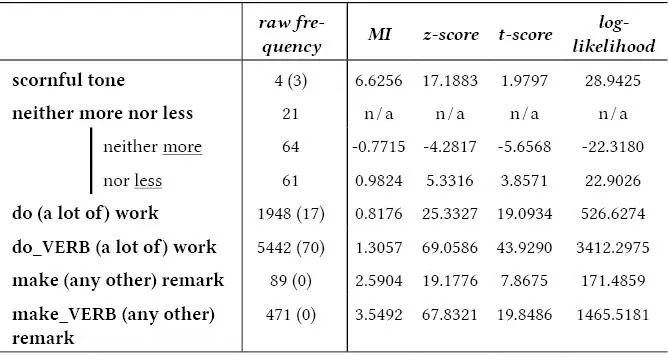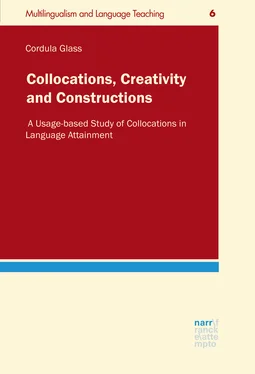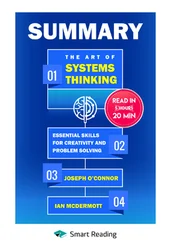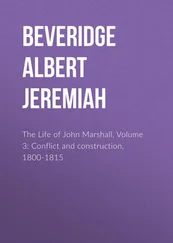Collocation is the cooccurrence of two items in a text within a specified environment. Significant collocation is regular collocation between items such that they co-occur more often than their respective frequencies and the length of text in which they appear would predict. Standard statistical tests can be used to tell whether the association between word A and word B is a significant one. (Jones/Sinclair 1974: 19)
Once again, true to contextualist tradition, the term is defined against the background of co-occurrence and context (“specified environment”). A new aspect is the additional dimension of observable frequency and with it the distinction between significant and casual collocations at its centre (Sinlcair 1966: 418). While basically any co-occurrence of lexical items could be considered a casual collocation , significant collocations are regarded to be special since two items co-occur more often than expected by chance. This correlation, however, can only be established by employing, as Sinclair points out, statistical tests. However, the nature of these tests and their results are, still today, a source of multifaceted debate (Evert 2005: 137–164; Sinclair/Jones/Daley 1970/2005: xxi).
Hence, a point of criticism which eventually arose (Granger/Paquot 2008; Herbst 1996) is that corpus research, by definition, depends to a large extent on the mathematical methods applied. Since each statistical test yields different results and suggests different interpretations, a more or less subjective factor as far as the decision for or against a methodology is concerned, cannot be denied. This ultimately means that whether a combination of lexical items is indeed significant or not still depends, to a certain degree, on the choice and intention of the author of a study8. Similar objections could be raised with regard to the corpus as such. Not every corpus is suitable for any kind of research question. Corpus size and design affect the outcome of most statistical tests, and some corpora might simply be too small to answer certain kinds of question, like, for example, a comprehensive collocational set for less frequent words, such as scornful . Furthermore, corpus evidence and statistically significant collocations need to address the question of relevance, because a significant correlation might also occur because of the topic and/or genre of a text and not because a certain combination is particularly salient (> 4.2.1). The same might be true for collocations which describe real world phenomena, like build , buy and sell as the most frequent verbal collocates for house (Herbst 1996: 388–389). However, Sinclair and his colleagues claim that “[…] at this moment it is impossible to prove or disprove this because the examination has been confined to text of one particular kind.” (Sinclair/Jones/Daley 1970/2005: 76) and therefore suggest that “[a]ll collocations must, therefore, be accepted at their face value, since they have all actually occurred more than three times in the sample of spoken language and have passed a fairly stringent significance test.” (Sinclair/Jones/Daley 1970/2005: 76).
Table 2.2 lists just a small selection of statistical measures, namely Mutual Information (MI), z-score, t-score and log-likelihood, for Humpty Dumpty’s “collocations” to demonstrate their respective effect on a potential interpretation. The results are taken from the BNC and, based on Sinclair’s suggestion (Jones/Sinclair 1974: 21–22), the span was set at four, with a minimum of occurrence of three (Sinclair/Jones/Daley 1970/2005: 42).

Table 2.2: Corpus-based association measures for “Humpty Dumpty’s collocations”
What becomes apparent immediately is that the result for each of the items selected differs depending on the respective statistical measurement. In other words, in a ranking scornful tone , for example, scores quite high when it comes to MI but has a relatively low t-score and log-likelihood value. This is, of course, due to the fact that each method focuses on a different parameter and, therefore, yields different results. While Mutual Information and z-score highlight collocations with a rather low frequency but strong likelihood to co-occur, t-score and log-likelihood show high-frequency pairs. For MI and t-score a result of two or three is considered to be statistically significant (Oakes 1998: 11–12.; Hunston 2002: 69–75; McEnery/Xiao/Tono 2006: 56). Chapter 5 will provide a more thorough discussion of tests for statistical significance; the crucial point to make at this stage is that depending on the method chosen, scornful tone , do work and make a remark could be regarded as statistically significant collocations.
None of these methods, however, brought to light the most frequent verbatim word combination neither more nor less . Of course, one could argue in favour of neither more nor less as a word-like, lexically stored chunk. Yet, there are possible variations, like I neither knew nor cared or neither the TV nor the video (OALD 7: neither ), which suggest an underlying constructional principle, like for example [neither X nor Y]. Scornful tone , on the other hand, might not be as relevant as the corpus analysis suggests, since, upon closer examination, three of the four hits are quotes of the very same passage, namely Humpty Dumpty’s and Alice’s conversation in Lewis Carroll Through the Looking-Glass . Despite the biased data for this co-occurrence, scornful tone could nevertheless qualify as a linguistically interesting word combination, or, to be more precise, the combination scornful and a noun phrase [ scornful +N], since, according to the BNC, all nouns with the premodification scornful can be subsumed under the semantic headline of “visual and auditive senses” and tone , in this case, behaves right along the line. There seems to be a kind of semi-lexically filled collocation, like [ scornful +N ] supporting the interpretation of a word combination like scornful tone . This phenomenon of underlying semantic properties of certain, partially fixed word combinations has also been observed by John Sinclair (1996, 1998, 2004) and Bill Louw (1993), who coined the term semantic prosody , which Gavioli later describes as “[…] the way in which words and expressions create an aura of meaning capable of affecting words around them.” (Gavioli 2005: 46; > 3.1).
Working with the COUBILD corpus, the Bank of English (BoE), Sinclair further realised that patterns like these are, in fact, themselves more pervasive in the English language than they would have been expected to be. He calls this the idiom principle or principle of idiom :
The principle of idiom is that a language user has available to him or her a large number of semi-preconstructed phrases that constitute single choices, even though they might appear to be analysable into segments. To some extent, this may reflect the recurrence of similar situations in human affairs; it may illustrate a natural tendency to economy of effort; or it may be motivated in part by the exigencies of real-time conversation. However it arises, it has been relegated to an inferior position in most current linguistics, because it does not fit the open-choice model. (Sinclair 1991: 110)
This observation stands in stark contrast to a traditional conception of language, which sees grammar and lexis as more or less detached from each other and lexical items as inferior to grammatical structures for which they simply serve as fillers for the slots they open up. In this respect, the notion of statistically significant collocations and the idiom principle can again be closely related to concepts within construction grammar, since both approaches take authentic language as a starting point and deduce more general linguistic principles from it. The purpose of the identification of these patterns and/or constructions in Sinclair’s research is, of course, very different from modern, cognitive-oriented corpus studies, which are mostly concerned with the mental representation of linguistic concepts and its consequences for language acquisition and learning (> 4). But the corpus-driven, inductive nature of corpus linguistics as a methodology makes it a valid tool for cognitive studies focusing on aspects like frequency of encounter , salience , pre-emption and entrenchment (Ambridge/Lieven 2011; Goldberg 2006; Stefanowitsch/Gries 2003). Furthermore, comparing potential collocates of a node word, looking at collocational sets, and identifying the most likely patterns of co-occurrence yields very similar results to what construction grammar has to offer in terms of underlying, partly delexicalised constructions within the English language system (> 5.1.2). Moreover, the functional side of semi-abstract constructions, like [ scornful +N], is also very similar to Sinclair’s notion of semantic prosody.
Читать дальше









![Chade-Meng Tan - Search Inside Yourself - Increase Productivity, Creativity and Happiness [ePub edition]](/books/703803/chade-thumb.webp)



